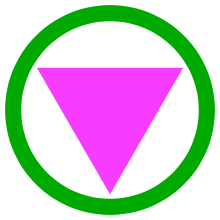Safe-space

| LGBT symbols | ||||||||
|---|---|---|---|---|---|---|---|---|
|
|
||||||||
|
||||||||
In educational institutions, safe-space (or safe space), safer-space, and positive space are terms used to indicate that a teacher, educational institution or student body does not tolerate anti-LGBT violence or harassment, but rather is open and accepting, thereby creating a safe place for lesbian, gay, bisexual, transgender, and all students.
A place where anyone can relax and be fully self-expressed, without fear of being made to feel uncomfortable, unwelcome, or unsafe on account of biological sex, race/ethnicity, sexual orientation, gender identity or expression, cultural background, age, or physical or mental ability; a place where the rules guard each person's self-respect and dignity and strongly encourage everyone to respect others.[1]—Advocates for Youth
An institution which supports a safe space for LGBT students and employees may offer staff training on diversity; includes being a safe space in the organization's mission; develops and posts a value statement in the organization's office, online, or on printed documents; or, if part of a coalition, encourages the coalition to include being a safe space in its mission and values.[2]
The concept originated in the women's movement, where it "implies a certain license to speak and act freely, form collective strength, and generate strategies for resistance...a means rather than an end and not only a physical space but also a space created by the coming together of women searching for community."[3] The first safe spaces were gay bars and consciousness raising groups.[3]
In 1989 GLUE developed a safe spaces program. During their events including diversity-training sessions and antihomophobia workshops, they passed out magnets with an inverted pink triangle, "ACT UP's...symbol", surrounded by a green circle to, "symbolize universal acceptance," and asked, "allies to display the magnets to show support for gay rights and to designate their work spaces free from homophobia."[4]
In gay-only groups, the desire for safe space may represent a "special ritual time spent in a ritual space" where "heterosexuals are cautiously avoided".[5] However, this may allow the comfort necessary for other actions. Mike Homfray observes, "Gay and lesbian people may perceive the pub or bar as being 'their' space, and so as somewhere they can 'perform' and be open without the fear of rejection or hostility from the heterosexual majority, which may be perceived as hostile." Homfray adds, "In this situation, the perception of safe gay space can allow the development of a sense of community and confidence, which in turn may contribute to the creation of rights-based movements."[6]
Canada
Positive Space initiatives are prevalent in post-secondary institutions across Canada including McGill University, the University of Toronto, the University of British Columbia, and Queen's University.[7][8][9]
United Kingdom
In early 2015 the increasing adoption of safe spaces in UK universities aroused controversy due to accusations that they were used to stifle free speech and right-wing political views.
See also
References
- ↑ "Glossary". Advocates for Youth. Retrieved 24 March 2012.
- ↑ "Tips and Strategies for Creating a Safe Space for GLBTQ Youth". Advocates for Youth. Retrieved 24 March 2012.
- ↑ 3.0 3.1 Kenney, Moira Rachel (2001). Mapping Gay L.A.: The Intersection of Place and Politics. p. 24. ISBN 1-56639-884-3.
- ↑ Raeburn, Nicole C. (2004). Changing Corporate America from Inside Out: Lesbian and Gay Workplace Rights. p. 209. ISBN 0-8166-3999-X.
- ↑ Kates, Steven M. (1998). Twenty Million New Customers!: Understanding Gay Men's Consumer Behavior. p. 100. ISBN 0-7890-0175-6.
- ↑ Homfray, Mike (2007). Provincial Queens: The Gay and Lesbian Community in the North-West of England. p. 78. ISBN 3-03910-930-8.
- ↑ Office of Student Life. "Positive Space Campaign". University of Toronto. Retrieved 18 June 2011.
- ↑ Queen's Positive Space Program. "The Queen's Positive Space Program". Queen's University. Retrieved 18 June 2011.
- ↑ Positive Space. "The Positive Space Campaign". University of British Columbia. Retrieved 18 June 2011.
External links
- "Creating Safe Space for GLBTQ Youth: A Toolkit", AdvocatesforYouth.org.
- "Safe Space Coalition", LDSSafeSpace.org.